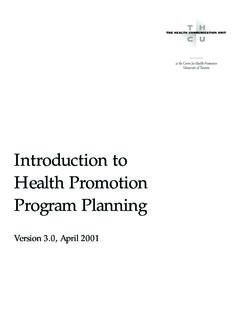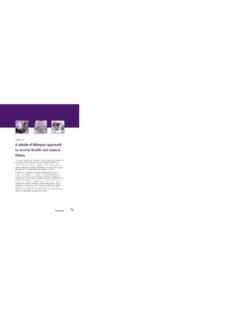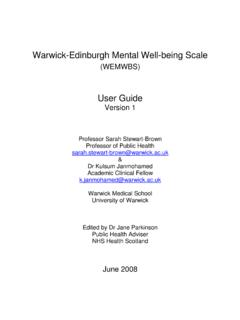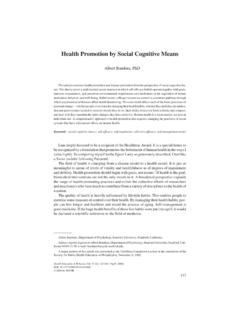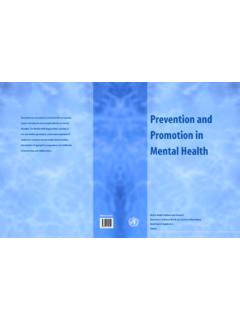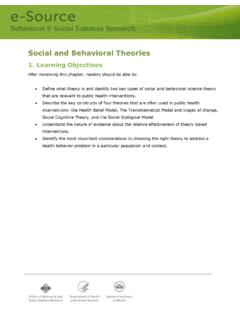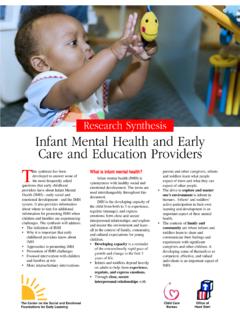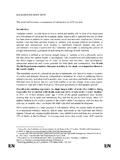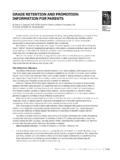Transcription of Occupational Stress: Factors that Contribute to its ...
1 A Report to theWORKERS COMPENSATION AND REHABILITATIONCOMMISSIONW estern AustraliaOccupational stress : Factors that Contribute to its Occurrence and EffectiveManagementCentre for Human ServicesGRIFFITH UNIVERSITYE lizabeth Kendall, MurphyVeronica O NeillSamantha BursnallAugust, 2000 Funded byWorkers Compensation and Rehabilitation Commission 2000 by WorkCover Western Australia This work is copyright. Extracts from the report may be reproduced without permission, provided that the source is acknowledged. Published August 2000 ISBN 0 7307 2693 2 Publications are available from the WorkCover Internet site: WorkCover Western Australia 2 Bedbrook Place Shenton Park WA 6008 Telephone: (08) 9388 5555 _____Occupational stress : Causes and Management ModelsiCentre for Human Services, Griffith UniversityJuly, 2000 AcknowledgementsThe authors of this report would like to acknowledge the support and assistance of manypeople in the preparation and editing of the manuscript.
2 In particular, thanks are due toNicholas Buys, , Jayne Clapton, , Jennifer Hall, Jane Fowler, VickyMacDonald, Greg McQueen, Ronita Neal, Tina Sandell, and John resources, consultation and encouragement provided by Diane Munrowd, DonnaHaney and Jemma Owen at WorkCover Western Australia are also , the financial support of the Western Australian Workers Compensation andRehabilitation Commission must be recognised as well as the opportunity they haveprovided to allow an investigation of work stress to be undertaken in their stress : Causes and Management ModelsiiCentre for Human Services, Griffith UniversityJuly, 2000 Table of ContentsProject Overview_____11. stress in the Value of of Work Stress_____5 Acute Stress_____7 Post Traumatic Stress_____7 Chronic Impact of Work Stress_____92. The Work stress Process_____143. Causative and Exacerbatory Vulnerability to Stress_____21 Personality Factors_____22 Negative Affectivity_____22 Cognitive Distortions and Negative Thinking Patterns_____24 Psychological Hardiness_____25 Coping Style_____26 Inadequate Personal or Environmental Resources_____27 Family-Work Demands_____30 Workload_____31 Time Pressure_____32 Performance Pressure_____33 Unclear Work Roles_____35 Conflict at Work_____36 The Emotional Demands of Climate_____39 Globalisation of the Economy_____39 The Impact of Interaction Between Worker and Culture and Role of Perceptions and Resource Management Practices_____55 Devolution of Responsibility in Human Resource Management_____57 Lack of Job Redesign Skills_____60 Inadequate Performance Appraisal and Counselling Procedures_____61 The Demise of Unionism and Employee Participation in Decision-Making_____63 Failure to Adhere to Occupational Health and Safety
3 Legislation_____65_____Occupational stress : Causes and Management ModelsiiiCentre for Human Services, Griffith UniversityJuly, Medicalisation and Legalisation of Stress_____66 The Dominant Role of the Medical Practitioner_____67 Imperfect Diagnostic Tools_____68 Diagnosing Work-Relatedness_____74 The Statutory and Legislative Management and Return to the Workplace_____80 Systemic Factors_____81 Key Stakeholders_____82 Delays to Return to Work_____83 Financial Benefits_____84 Stigma of Returning to the Same Workplace_____84 Demographic Factors_____864. Management Prevention and Management_____88 The Healthy Organisation_____90 Legislative Base for the Healthy Management Strategies_____95 Medical Management_____96 Employee Assistance Management Strategies_____103 Case Management_____104 Injury Management_____108 Disability Management_____1105. Methodological Issues_____1116. Conclusions and Implications_____1167. References_____120_____Occupational stress : Causes and Management Models1 Centre for Human Services, Griffith UniversityJuly, 2000 Project OverviewThe Western Australian Workers Compensation system, like many other jurisdictions,has recently undergone a major review designed to investigate spiraling costs associatedwith its administration.
4 One area where costs have been found to be particularly high,regardless of the jurisdiction, is the area of Occupational stress1. The Western Australianreview indicated a need to focus on achieving the broad objectives of equity, early returnto work and safe workplaces rather than focusing on the causes of increasing costs(Pearson, McCarthy & Guthrie, 1999). However, of all the injury types dealt withthrough the compensation system, work-related psychological injury ( , Occupational orwork stress ) presents the greatest barrier to the achievement of these objectives becausethe area is plagued by conceptual confusion, practical barriers and phenomenon of increasing Occupational stress was formally identified in 1989, whenthe Commonwealth Commission for the Safety, Rehabilitation and Compensation ofCommonwealth Employees (Comcare) initiated several research projects. During thesubsequent decade, prolific writings have emerged about Occupational stress .
5 Anabundance of precipitating or exacerbating Factors have been identified and a multitude ofmanagement programmes have been initiated. During the same period, the percentageincrease in claims for work-related psychological injury has been greater than any otherinjury (Pearson et al., 1999). Although this increase may reflect Factors such as changinglegislation or increased reporting, the juxtaposition of increasing claims against theincreasing level of knowledge is both alarming and the volume of literature that is available about work stress , few definiteconclusions can be drawn because of: (1) the elusive nature of 'work stress ' as a concept;(2) methodological issues in the identification of contributing Factors ; (3) inadequateevaluation of management strategies; and (4) failure to consider the continuum from_____Occupational stress : Causes and Management Models2 Centre for Human Services, Griffith UniversityJuly, 2000prevention to return to work as a coherent, single entity rather than dealing with itscomponents literature review represents the introductory phase of a multi-part empirical studythat will investigate work-related stress from the perspectives of all relevant parties in anattempt to (1) identify key Factors which Contribute to the phenomenon of work stress ; (2)examine the problems and success Factors associated with the management of work-related stress claims; and (3) investigate the practices associated with the return to workprocess for people with psychological conditions.
6 Prior to initiating the empirical studies,there was a need to synthesise the vast array of literature on this topic and draw somerelevant conclusions regarding the following critical issues:1. the definitions, incidence and impact of stress in the workplace;2. the Factors that are believed to Contribute to the occurrence of stress and/ora claim for psychological injury or illness 2; and,3. the management strategies that are currently adopted in response tooccupational it is acknowledged that workers who experience stress at work may not proceed tothe point of lodging a claim for psychological injury, it is necessary to understand theentire experience of work stress . Consequently, this review will examine issues inrelation to the experience of both work-related stress and the lodgement of a claim forpsychological The terms ' Occupational stress ', 'work stress ', job stress and work-related stress are usedinterchangeably in the literature and across different stress at work is usually referred to as psychological injury or illness.
7 Jurisdictions differ interms of whether they classify stress as an injury or an illness. In Western Australia, stress isgenerally considered to be a stress : Causes and Management Models3 Centre for Human Services, Griffith UniversityJuly, 2000 Section 1 stress in the WorkplaceOccupational stress and workplace health have become issues of great concern over thelast decade, both internationally and nationally. Given the value of work in this society,the amount of time spent at work and the current changes that are affecting the nature ofwork, it is not surprising that work stress appears to be increasing (Szymanski, 1999).For instance, as a result of the rapidly changing global economy, organisations nowoperate in cultures of increased speed, efficiency and competition. Consequently,economic imperatives and the need to retain competitive advantage have resulted inrestructuring and uncertainty.
8 For instance, workforces are constantly being downsized,small organisations are merging or being subsumed by larger more competitiveorganisations, and change is the only changes to the nature of work, together with definitional changes in the legislation,have paved the way for an alarming rise in claims that are associated with chronic stressin the workplace. In previous years, stress claims were mostly associated with theexperience of a traumatic and/or life threatening event, such as violence, injury or acritical incident of some kind. Occupations most at risk of experiencing these types ofevents included police and prison officers, medical and paramedical professionals,banking staff, and community care workers (National Institute for Occupational Safety &Health NIOSH, 1999). In recent years, however, the number of claims has beensteadily increasing and the reported cause for these claims has moved away fromtraumatic stress to chronic conditions (Bull, 1996).
9 This type of stress creates enormouscosts, both financially and in human-terms, although the costs are difficult to quantify asa result of misleading statistics, unreported instances, staff turnover and stress : Causes and Management Models4 Centre for Human Services, Griffith UniversityJuly, Value of WorkAny discussion of work stress must avoid making the impression that work is apsychologically dangerous activity as it is not necessarily inherently stressful. Indeed,the intrinsic value of work to the health and life satisfaction of the worker is wellrecognised (Probert, 1990). Early philosophers such as Freud and Adler contended thatwork forms an integral part of basic human existence. In his well-accepted theory ofdevelopment, Erikson (1950) noted the importance of work to an individual s sense ofselfhood. Motivational theorists such as Maslow (1968) have suggested that work doesnot only fulfill basic needs for security, food or shelter, but also provides a means bywhich higher level needs, such as need for competence, meaning and social engagementare recent researchers have shown that work is integrally involved in the process ofidentity development and self-esteem (see Winefield, Winefield, Tiggemann & Goldney,1993).
10 Work, therefore, plays a major role in people s lives and wields an importantinfluence on their sense of well-being and identity (Barling, 1990; Feather, 1990). Itprovides a medium by which people identify themselves in society (Symanski, Ryan,Merz, Trevino & Johnston-Rodriguez, 1996); and can be influenced by economic,societal, cultural and individual Factors . As noted by Kielhofner (1995), a person sidentity is a function of his or her validated social roles, particularly those associated withoccupation. Consequently, the loss of such valued roles can lead to psychological distressand subsequent loss of many individuals, the loss of work has been associated with extremely negativereactions that include psychological or physiological distress, loss of social contact andsuicide (Jahoda, 1979; Keita & Sauter, 1992; Marshall & Hodges, 1981; Winefield,1995).
